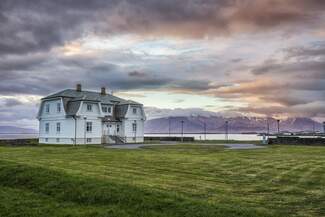
Höfði House
Borgartún 1, 105 Reykjavík, 411 1111
Website: en.wikipedia.org/wiki/höfði
Email: upplysingar@reykjavik.is
The Höfði building has a very remarkable history. In the 104 years since it was taken into use, there have been consuls, ambassadors, poets, and artists among others, living there. Höfði is today the mayor's reception hall.
Höfði house was taken into use in 1909 and has a remarkable history related to Icelanders' relations with other nations. The house was built at Félagstún for the French consul, Jean-Paul Brillouin. It was designed in Eastern Norway and exported to Iceland. The building shows influences from the Art Nouveau style, classic neo-baroque, and Norwegian national romanticism. In the reception room, Brillouins' name is written in golden letters on the door along with the year of construction of the house.
Höfði had a great sense of dignity in the first decades. After Brillouin, Einar Benediktsson, a poet and entrepreneur, lived here with his family. The longest residence was by the family of doctor Matthías Einarsson.
From 1938 until the end of the war, Höfði was the seat of consul and later for the ambassador of Britain. The Prime Minister of the United Kingdom Winston Churchill, and the singer and actress Marlene Dietrich visited the house during the war years. From the middle of the 20th century, a large number of people lived in Höfði for a longer or shorter period of time and there was also a business there at some point.
The city of Reykjavík bought the house in 1958 and in the following years, it was renovated and restored to its former glory. Since 1967, Höfði has been a venue for city receptions.
Famous is the Reagan-Gorbachev summit in Höfði in October 1986, which is believed to mark the beginning of the end of the Cold War. Iceland was the first nation to recognize the restoration of the independence of the Baltic States, and a declaration to that effect was signed in Höfði in August 1991.